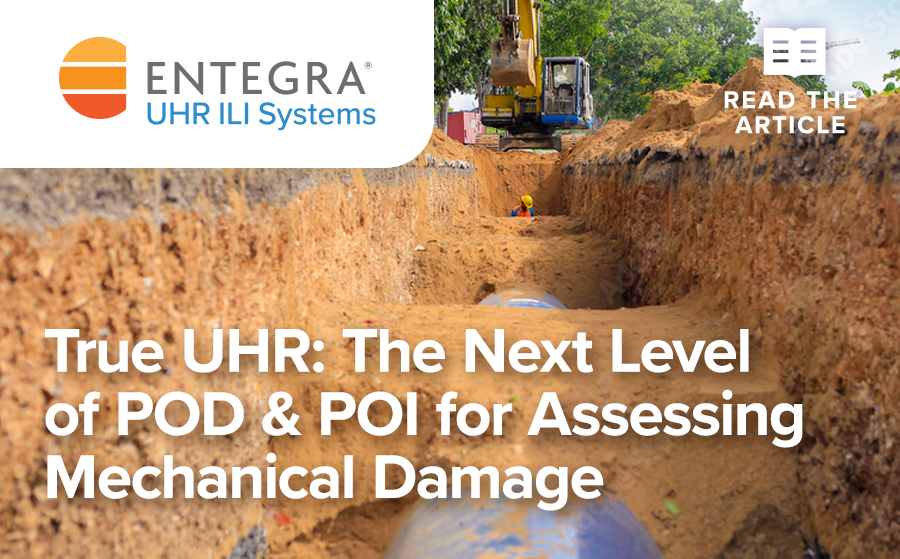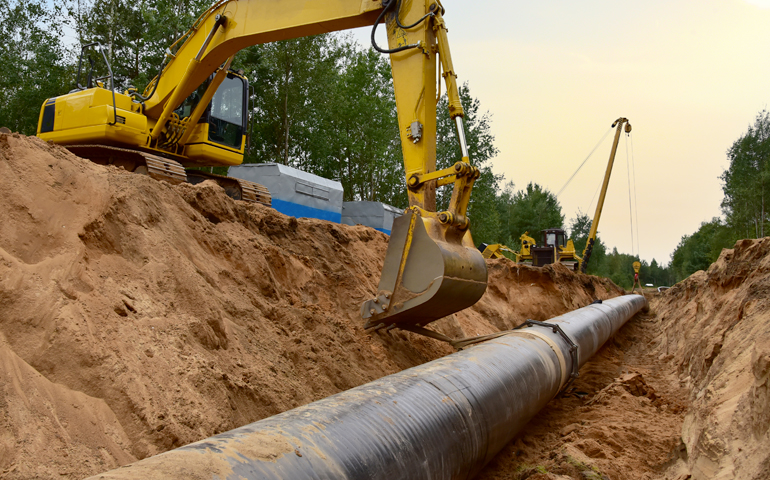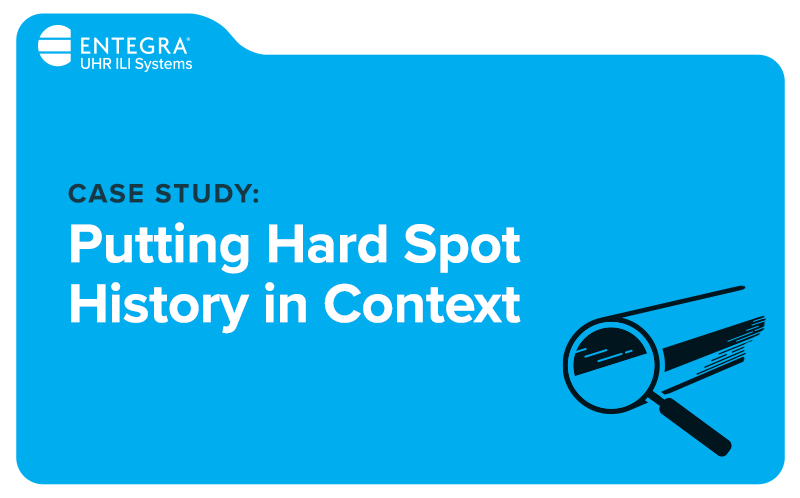
Pipeline Mechanical Damage and the Benefits of UHR ILI
Mechanical damage to a pipeline presents a unique obstacle to operators looking to get a complete picture of pipeline integrity. Damage caused by the impact of outside forces on a pipeline can result in plain dents, dents with gouges or gouges without associated deformation. Whether the damage itself poses a threat, or corrosion occurs coincidental …
Mechanical damage to a pipeline presents a unique obstacle to operators looking to get a complete picture of pipeline integrity. Damage caused by the impact of outside forces on a pipeline can result in plain dents, dents with gouges or gouges without associated deformation. Whether the damage itself poses a threat, or corrosion occurs coincidental with that damage, it is a serious concern that has been classified as a top-3 cause of pipeline leaks.
The real challenge? Differentiating this mechanical damage from metal loss or metal gain. Obtaining such a nuanced assessment can be particularly frustrating to operators and ILI solutions partners, alike. Particularly since mechanical damage can impede the accurate collection of ILI data. This is where Ultra-High-Resolution (UHR) really distinguishes itself.
Working in conjunction with the operator, ILI solution providers use historical survey data as well as inspection and remediation records in combination with UHR ILI and human-experienced based data analysis to deliver next-generation solutions to the mechanical damage problem. Let’s look at this system in action.

The Problem: Mechanical Damage
Mechanical Damage is defined by API 1163 as pipe damage caused by an application of external forces. As mentioned, these can take the form of plain dents, dents with a gouge, or gouges without associated deformation.
Plain dents are dents without any associated metal loss from gouging. It’s a common problem – often a pipe is laid on top of an object such as rock during construction. This results in a bottom side dent. Plain dents can also be found on the top side of the pipe, though by themselves, they tend to be less of an integrity threat when compared to dents with gouges or gouging alone. Plain dents that happen to have corrosion nearby often lead to false positives (and many times an unnecessary dig) without the detail available through UHR technology.

Dents with gouges, on the other hand, are more serious and typically found on top of the pipe often caused by 3rd party activity over the pipeline. Examples include an excavation impacting the top of the pipe, a bore or a directional drill hitting the pipe, or a farmer hitting the pipe with a tiling machine.

Another concern: gouges that occur when metal is mechanically removed from the pipe material without any associated deformation. Here, too, damage is typically caused by 3rd party activity over the pipeline.

This kind of damage is particularly troublesome because gouges – with or without associated denting – can cause the material structure itself to change and leave sharp edges that can facilitate future cracking. What’s more, gouges are particularly difficult to identify. Prior to the availability of a true UHR Axial MFL ILI system, such gouges could only be inferred when metal loss was determined to be associated with a deformation. Put simply, differentiating between corrosion and a gouge on a standalone basis had a demonstrably lower Probability of Identification prior to UHR.

The Solution: Ultra High Resolution
A true UHR system — state of the art technology backed by industry-leading Data Analysis — allows operators and their ILI partners to detect, identify and size corrosion interacting with a range of pipeline features. This provides a more complete and accurate picture of the threats that mechanical damage poses for virtually every possible scenario. It also allows for better decision making across the board.
A UHR MFL ILI system affords higher sensor and sampling density across all sensor types (MFL, CAL and ID/OD). As discussed, this is paired with a data analysis system centered on human-experience, insight and decision making. This is the heart of the system and allows for differentiation between gouges, corrosion, manufacturing/mill metal loss and association with deformation (or lack thereof).
The real value? Helping operators save on unnecessary digs or by facilitating better dig prioritization (depending on the operator’s policy). Also, standalone gouges (gouges not associated with a measurable deformation) can be differentiated from corrosion metal loss, eliminating potential false negatives by correctly identifying a potentially injurious anomaly. Being able to differentiate between mechanical damage and corrosion is key.
Below, we have an excellent example showing how, with UHR data, the general shape of an anomaly presents different magnetic responses. A gouge, which is typically cone shaped with sharp edges, shows in the data as markedly different than corrosion, which is generally more rounded or parabolic. Assessing the sum of the peripheral context provided by UHR gives analysts a better understanding of the nuances between mechanical damage and pits of corrosion.

Case Study: The Proof is in Performance
It all comes down to building enough context around each anomaly to correctly detect it, identify it and assess its relative threat.
In the case of this 8”, ERW gas pipeline, it was discovered that available historical data was unreliable. It contained inconsistencies in the classification of what appeared to be a metal loss feature. As you can see from this illustration, the historical CMFL and Multi-Data Set Technology couldn’t offer the same contrast and detail afforded by the UHR MFL technology.

Only the UHR AMFL showed a clear indication of a close metal object in the vicinity of the metal loss feature. The nuanced data revealed subtle gouging signatures not readily apparent in the historical data. Based on the experience of the data analyst reviewing this data, the shape of the deformation implied that another pipe was laid perpendicular to this pipe.

The UHR ILI system correctly predicted the anomaly to be a dent with a gouge containing metal loss, a condition which immediately raised this anomaly’s threat level. The outcome: a confirmation dig and repair of a potentially harmful defect that would have otherwise been missed.
Conclusion
You can readily see how a combination of state-of-the-art UHR technology and DA experience can help with the POD, POI and assessment of mechanical damage. Most importantly, Ultra-High-Resolution ILI can differentiate gouges from corrosion, significantly reducing both false positives and, more importantly, false negatives. A UHR ILI system can help minimize risk, mitigate integrity threats, and help operators prioritize – and get ahead of – their remediation programs. From the technology itself to the human-experience based data analysis and reporting behind it, UHR ILI is achieving results previously thought next to impossible. Think of it as going beyond POD and POI to ROI in helping today’s operators to meet the moral and regulatory responsibilities to know their pipeline. And grow their business.
The ENTEGRA Difference
Applying the latest technology and human-based insight, vision and analysis to solve real-world-problems. Putting that knowledge to work. Rinsing and repeating. That is the ENTEGRA approach to UHR in-line inspection and its application in dealing with complex corrosion. It is something that has evolved – from a technical perspective, an engineering perspective, and a people perspective – since before ENTEGRA’s founding in 2016 by the same team of engineers, operators, analysts, and field professionals who first commercialized the MFL/Combo tool more than two decades ago.




